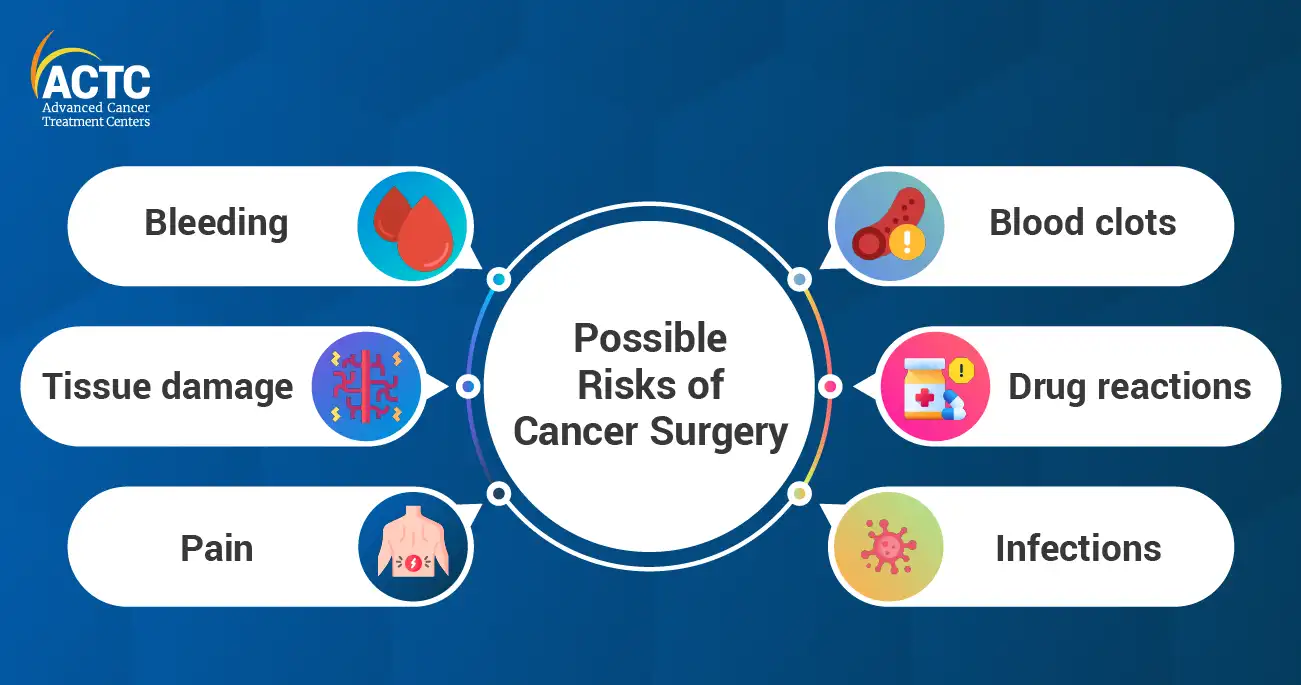
Book a Consultation
Thank you!
Your form has been sent successfully.



October 30, 2023
Cancer surgery is an essential part of cancer treatment that oncologists may recommend for initial diagnosis, staging, treatment, or even managing palliative conditions. There are several different types of cancer surgeries, each tailored to the specific needs and characteristics of the disease. With medical advancements, cancer treatment centers are now offering less invasive and more effective surgical options for cancer.

In most cases, healthcare providers consider surgery as an option to diagnose cancer. To confirm a cancer diagnosis, healthcare providers take out a small piece of tissue, known as a sample, and test it under a microscope. This method is commonly known as surgical biopsy.
Providers determine the method of biopsy depending on the tumor location and the type of cancer they suspect.
Oncologists recommend this type of surgery to detect the extent of cancer and how far it has spread. During the staging surgery, healthcare providers examine the affected part as well as the surrounding area, including lymph nodes and nearby organs.
Staging surgery helps the cancer care team curate personalized cancer treatment plans by providing crucial information about the tumor or abnormal cells. It can also help them predict how individuals will respond to treatment.
Also known as primary surgery, the curative surgical procedure is usually suggested by medical teams when they find cancer in only one part of the body. In such cases, the likelihood of removing all the cancerous cells or tumors is higher than in advanced cases.
Healthcare professionals usually suggest surgery as the primary treatment for early-stage cancer. They may also recommend additional treatments like chemotherapy, radiation therapy, etc., before or after the surgery to increase the chances of recovery.
Healthcare providers order prophylactic or preventive surgery to remove body tissues that can become cancerous. They may recommend this type of surgery even when there are no signs of abnormal growth during their initial checkup.
Sometimes, the medical team may suggest the removal of an entire organ if a person has an underlying condition or genetic factors that put them at very high risk for developing cancer. Although preventative surgery can reduce cancer risk, it does not guarantee complete cancer prevention.
For instance, oncologists may recommend preventive surgery to women with a strong family history of breast cancer where an inherited change in a breast cancer gene (BRCA1 or BRCA2) is involved. In such cases, surgeons may perform prophylactic mastectomy or complete breast removal.
This procedure is called ‘debulking’ because healthcare professionals treat the tumor as a large, bulky object located near important organs or tissues. Therefore, removing the entire tumor may be extremely risky and cause severe damage to nearby organs or tissues. In this case, surgeons remove a part of the tumor or ‘de-bulk’ it and prevent it from growing or spreading further.
Oncologists often suggest this surgery for advanced ovarian cancer and some lymphomas. Once the providers complete the procedure, they may recommend radiation, chemotherapy, or other treatments to eliminate the remaining tumor or cancerous cells.
It is usually a part of the treatment plan for advanced cancer, where the main goal of the treatment is to relieve pain and discomfort.
For instance, if an abdomen tumor has grown large enough to obstruct the intestine, healthcare professionals may suggest a surgical procedure to remove the blockage. Palliative surgery can also relieve pain when it is difficult to control with medication and other treatment procedures.
Supportive surgery can assist individuals in getting other forms of cancer treatment. For instance, oncologists may recommend placing a vascular access device, a thin, flexible tube, into a large vein and connecting it to a small drum-like device under the skin. This device can facilitate treatments and help draw blood, give IV fluids, perform blood transfusions, etc.
Sometimes, eyelid or breast surgery may leave visible deformities which can significantly affect the quality of life. The goal of reconstructive surgery is to improve how a person looks or restore the function of an organ after major cancer surgery. For instance, surgeons may perform eyelid reconstruction surgery to increase its functionality.
According to the American Cancer Society, these are some of the most common types of cancer surgeries.
Cancer surgery can be invasive or non-invasive, depending on the type of cancer and its spread. The primary aim of surgery is complete cancer removal, but it may require the removal of some surrounding healthy tissues as well. Surgeons may also consider extracting lymph nodes to reduce the risk of cancer spread. Surgical techniques have been evolving, with advanced cancer treatment procedures focusing more on less invasive approaches.
Other cancer surgery techniques include:
Cryosurgery: Using extreme cold to freeze and destroy cancer cells
Electrosurgery: Utilizing electric current to eliminate cancer cells
Laser surgery: Employing light beams to shrink or eliminate cancer cells
Mohs surgery: Removing cancer layer by layer, especially for skin cancers near sensitive areas like the eyes
Laparoscopic surgery: Minimally invasive surgery with small incisions and insertion of a camera for precision
Robotic surgery: Surgeon-controlled robotic tools for intricate procedures
Natural orifice surgery: Operating on internal organs through natural body openings (e.g., mouth, rectum, vagina) to potentially reduce pain
Preparation for cancer surgery and recovery varies for every individual, depending on the specific procedure performed and how their body adapts to it. However, the National Cancer Institute outlines the following common elements that individuals can expect before and after surgery:
Before the procedure, healthcare providers may order several pre-surgery tests, including blood and urine tests, X-rays, and other imaging exams. These tests help the surgeons plan the surgery and assess any potential risks associated with underlying medical conditions.
Surgery typically requires anesthesia to manage pain. The type of anesthesia administered depends on the nature of the surgical procedure.
Depending on the complexity of the surgery, individuals may have to spend a few days in the hospital before being discharged. The medical team usually provides precise post-operative care instructions, including wound care, dietary restrictions, activity limitations, and medication. Individuals also need to follow the return-to-work guidelines provided by their healthcare provider. Strictly adhere to any follow-up visits with the surgeon that may involve stitch removal and healing assessments as scheduled.

There may be some risk of complications after the surgical procedure, resulting from the medications administered, wound care, and overall health of a person. Generally, more complex surgeries pose a higher risk of side effects.
Possible side effects during and after surgery may include the following:
It occurs either internally or externally and may require further intervention, such as a transfusion if it is severe.
Clotting is particularly common in the legs and is easily treatable. But blot clots can lead to alarming complications if they dislodge and travel to other body parts.
Internal organs and blood vessels may sustain damage during complex surgeries. However, advanced surgical equipment and procedures aim to minimize these issues.
It is a rare but potentially severe side effect of anesthesia or other medications, which can significantly drop blood pressure.
It is a usual post-surgery experience that does not hinder recovery in general. Healthcare providers may prescribe pain management options as required.
Despite preventive measures, infections at the incision site can occur, which are typically treated with antibiotics.
In addition, some bodily functions, like bowel activity, may take longer to recover. To prevent these complications, healthcare professionals carefully assess and manage a person's health condition before surgery and closely monitor vital signs during the procedure.
Recovery and the degree of side effects differ for everyone. While some people experience mild side effects, others may go through severe pain. Individuals should contact their healthcare provider or cancer treatment center right away if they suffer from any of the following symptoms after surgery:
High fever with chills
Uncontrollable bleeding from the incision surgical site or drain site
Worsening pain or soreness at the surgical site not relieved with the pain medicine
Unexplained pain anywhere, including in your legs, chest, belly, etc.
Severe headaches
Shortness of breath
Unusual changes in urine or difficulty urinating
Any other signs mentioned by the healthcare team
For any queries or concerns about cancer treatment, including surgical options, contact ACTC, a leading cancer center in Florida. We are one of the best cancer treatment centers in America, equipped with advanced cancer treatment facilities. Visit our website or contact us at +1 352-345-4565 to schedule an appointment now!



November 13, 2025
Food choices feel high-stakes during cancer care, and because of that,...
KNOW MORE

November 13, 2025
Ablation treats prostate cancer using energy such as heat, cold, elect...
KNOW MORE

November 13, 2025
Discovering a fast-growing bump on your skin can cause immediate worry...
KNOW MORE

November 13, 2025
Triple negative breast cancer (TNBC) is one of several kinds of breast...
KNOW MORE

June 03, 2024
The last decade has witnessed a sea change in oncologic treatments. Re...
KNOW MORE

April 17, 2024
Oncology is one of the most exciting fields in medicine today. Disease...
KNOW MORE
